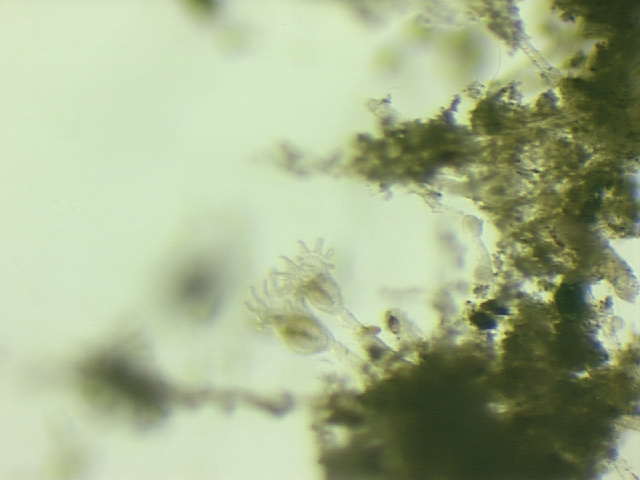Description
Taxonomy
| Kingdom | Phylum | Class | Order | Family | Genus |
|---|---|---|---|---|---|
| Animalia | Entoprocta (Kamptozoa) | None | Coloniales | Pedicellinidae | Loxosomatoides |
Synonyms
Invasion History
Chesapeake Bay Status
| First Record | Population | Range | Introduction | Residency | Source Region | Native Region | Vectors |
|---|---|---|---|---|---|---|---|
| 1994 | Established | Expanding | Introduced | Regular Resident | Western Pacific | Western Pacific | Shipping(Fouling Community) |
History of Spread
Loxosomatoides laevis kamptozoan (or entoproct ) was described from Chilka Lake, an estuary of the Bay of Bengal, India, in 1915, and found in Japan in 1951. All but one of the other members of the genus are confined to Asian waters; one South American species may belong to another genus (Wasson et al. 2000). It was not collected in early studies of entoprocts in the Chesapeake Bay (Osburn 1944) or other East Coast sites (Woods Hole MA, NC, SC) (Wasson et al. 2000).
Loxosomatoides laevis' only known occurrences outside the Indo-Pacific have been in Chesapeake Bay, where it was first identified on the Smithsonian Envrionmental Research Center Marine Invasions Program settling plates in 1994, in sites in upper and lower Chesapeake Bay. In 1994-1997, it was collected in the Chester River (MD), Baltimore Harbor; the Rhode River and West Rivers (MD); and Norfolk Harbor VA (Wasson et al. 2000).
History References- Osburn 1944; Wasson et al. 2000; Ruiz et al. unpublished data
Invasion Comments
Ecology
Environmental Tolerances
| For Survival | For Reproduction | |||
|---|---|---|---|---|
| Minimum | Maximum | Minimum | Maximum | |
| Temperature (ºC) | 32.0 | |||
| Salinity (‰) | 5.0 | 28.0 | ||
| Oxygen | ||||
| pH | ||||
| Salinity Range | meso-poly |
Age and Growth
| Male | Female | |
|---|---|---|
| Minimum Adult Size (mm) | 0.6 | 0.6 |
| Typical Adult Size (mm) | 0.8 | 0.8 |
| Maximum Adult Size (mm) | 1.0 | 1.0 |
| Maximum Longevity (yrs) | ||
| Typical Longevity (yrs |
Reproduction
| Start | Peak | End | |
|---|---|---|---|
| Reproductive Season | |||
| Typical Number of Young Per Reproductive Event |
|||
| Sexuality Mode(s) | |||
| Mode(s) of Asexual Reproduction |
|||
| Fertilization Type(s) | |||
| More than One Reproduction Event per Year |
|||
| Reproductive Startegy | |||
| Egg/Seed Form |
Impacts
Economic Impacts in Chesapeake Bay
Although it is an abundant fouling organism in Chesapeake Bay, because of its small size, the kamptozoan Loxosomatoides laevis has no economic importance in the Chesapeake Bay region.
Economic Impacts Outside of Chesapeake Bay
Although it is an abundant fouling organism in Chesapeake Bay, because of its small size, the kamptozoan Loxosomatoides laevis has no economic importance in its known range.
Ecological Impacts on Chesapeake Native Species
Effects of Loxosomatoides laevis on native biota are unknown for Chesapeake Bay and elsewhere. However, it is striking that during the SERC Invasions Group settling plate surveys, none of the native entoproct species reported by Osburn (1944) from the Bay were found. Many of his collections were made in Atlantic Coastal bays, where setling plates have not been deployed. However, it is possible that the native species have been replaced by the introduced entoprocts.
References- Ruiz et al. unpublished; Wasson 1997; Wasson et al. 2000
Ecological Impacts on Other Chesapeake Non-Native Species
Effects of Loxosomatoides laevis on introduced biota are unknown for Chesapeake Bay and elsewhere.
References
Barnes, Robert D. (1983) Invertebrate Zoology., , Philadelphia. Pp. 883Cohen, Andrew N.; Carlton, James T. (1995) Nonindigenous aquatic species in a United States estuary: a case study of the biological invasions of the San Francisco Bay and Delta, , Washington DC, Silver Spring MD.. Pp.
Osburn, Raymond C. (1944) A survey of the Bryozoa of Chesapeake Bay, Chesapeake Biological Laboratory Publications 63: 1-55
Wasson, Kerstin (1997) Systematic revision of colonial kamptozoans (entoprocts) of the Pacific coast of North America, Zoological Journal of the Linnean Society 121: 1-63
Wasson, Kerstin; Toft, Jason; Von Holle, Betsy; Ruiz, Gregory (2000) Detecting invasions of marine organisms: kamptozoan case histories., Biological Invasions 2: 59-74
